In-class Film-viewing for Empathy Development in Higher Education
Main Article Content
Abstract
In the 2016 winter term, I taught a course on French communication for English as a Second Language pre-service teachers (PST) in the Department of Education of a Canadian university. In this narrative autoethnography, I present the perspectives emerging from a university teaching experience of “teaching through film”, with undergraduate students enrolled in my French communication course. In-class discussions gravitated towards values and morals—notably empathy and caring—in relation to the significance of being or embodying a “good teacher”, following the viewing of Monsieur Lazhar (2011). Drawing on William Ayers’ philosophy of good teaching, among others, I present the implications of these discussions for teacher education and their significance for teacher training programs.
Keywords: Film; Empathy; Artwork; Higher Education; Narrative Autoethnography
Downloads
Article Details

This work is licensed under a Creative Commons Attribution-ShareAlike 4.0 International License.
The copyright notice is CC BY SA.
This license lets others remix, tweak, and build upon your work even for commercial purposes, as long as they credit you and license their new creations under the identical terms. All new works based on yours will carry the same license. Thus any derivatives will also allow commercial use. For example, if someone translates your article into French, the French version of the article will also have to be shared under a CC BY SA license.
References
Agne, K. (1999). Caring: The way of the master teacher. In R. P. Lipka & T. M. Brinthaupt (Eds.), The role of the self (pp. 165-188). New York, NY:State University of New York Press.
Arendt, H. (1968). The crisis in education. In H. Arendt, Between past and future: Eight exercises in political thought. New York, NY: Penguin.
Ayers, W. (2001). To teach: The journey of a teacher. New York, NY: TeachersCollege Press.
Barthes, R. (1977). Image, music, text (S. Heath trans.). New York, NY: Hill and Wang.
Canadian Criminal Code, Section 43 (2008, PRB 05-10E). Retrieved from the Parliament website: http://www.lop.parl.gc.ca/content/lop/researchpublications/prb0510-e.htm#endnote2
Carroll, N. (2003). Aesthetics and the educative powers of art. In R. Curren (Ed.), A companion to the philosophy of education (pp. 365-383). Oxford, UK: Wiley-Blackwell.
Chilton, G, Gerber, N., Bechtel, A., Councill, T., Dreyer, M., & Yingling, E. (2015). The art of positive emotions: Expressing positive emotions within intersubjective art making process. Canadian Art Therapy Association Journal, 28(1-2), 12-25.
Durand, M.-J., & Chouinard, R. (2012). L’évaluation des apprentissages : De la planification de la démarche à la communication des résultats (revised edition). Montréal: Marcel Didier.
Eaton, M. M., & Moore, R. (2002). Aesthetic experience: Its revival and its relevance to aesthetic education. Journal of Aesthetic Education, 36(2), 9-23.
Elliot-Johns, S., Booth, D., Rowsell, J., Puig, E., & Paterson, J. (2012). Using student voices to guide instruction. Voices from the Middle, 19(3), 25-31.
Ellis, C. (2004). The ethnographic I: A methodological novel about
autoethnography. Walnut Creek, CA: AltaMira Press.
Ellis, C., Adams, T., & Bochner, A. P. (2010). Authoethnography: An
overview. Forum: Qualitative Social Research, 12(1), article 10.
Ellis, C., & Bochner, A. P. (2000). Autoethnography, personal narrative, reflexivity: Researcher as subject. In N. Denzin & Y. Lincoln (Eds.), Handbook of qualitative research (second edition), (pp. 733-768). Thousand Oaks, CA: Sage.
Falardeau, P. (2011). Monsieur Lazhar [motion picture]. Montréal, QC:micro_scope.
Freire, P. (1996). Pedagogy of the oppressed. Harmondsworth, UK: Penguin Books.
Frondizi, R. (1971). What is value? An introduction to axiology (second edition). LaSalle, IL: Open Court Publishers.
Griffith, J., & Hébert, C. (2015). Un/bearable witnessing: Sex scandal, historical trauma, and literature of historical witness in Monsieur Lazhar. In N. Ng-a-Fook, G. Reis & A. Ibrahim (Eds.), Provoking curriculum studies:Strong poetry and arts of the possible in education (pp. 173-184). London,UK: Routledge.
Incaprera, J. (2017). 13 reasons why [television series]. San Francisco, CA: Netflix.
Ladson-Billings, G. (2001). Foreword. In W. Ayers (Ed.), To teach: The journey of a teacher. New York, NY: Teachers College Press.
Lawrence, R. L. (2008). Powerful feelings: Exploring the affective domain of informal and arts-based learning. New Directions for Adult and Continuing Education, 7, 65-77.
Lebrun, M., Lacelle, N., & Boutin, J.-F. (2013). La littératie médiatique à l’école : Une (r)évolution multimodale. Globe : Revues internationale d’études québécoises, 16(1), 71-89.
Lemieux, A. (2016). Moments de réception en lecture et en spectature : Le cas d’Incendies au CEGEP. Revue de recherches en littératie médiatique multimodale, 3, November, Special Issue, « Digital writing in schools : New textualities, new outcomes ».
http://www.litmedmod.ca/moments-de-reception-en-lecture-et-en-spectature-le-cas-dincendies-au-cegep
Maine, F. (2015a). Dialogic readers: Children talking and thinking together about visual texts. London, UK: Routledge.
Maine, F. (2015b). Teaching comprehension through reading and responding to film. Leicester, UK: The United Kingdom Literacy Association.
Michael, C. (2013). Behind closed doors: Monsieur Lazhar and the francophone classroom film. Québec Studies, 56(Fall/Winter), 29-40.
National Association of School Psychologists (NASP). “13 Reasons Why” Netflix Series: Considerations for educators. Bethesda, MD.
Noddings, N. (1992). The challenge to care in schools: An alternative
approach to education. New York, NY: Teachers College Press.
Nussbaum, M. C. (1998). Cultivating humanity: A classical defense of reform in liberal education. Cambridge, MA: Harvard University Press.
Palmer, P. (1998). The courage to teach. San Francisco, CA: Harper and Row.
Rowsell, J. (2013). Working with multimodality: Rethinking literacy in a digital age. London, UK: Routledge.
Rowsell, J., & Walsh, M. (2011). Rethinking literacy education in new times: Multimodality, multiliteracies, & new literacies. Brock Education, 21(1), 53-62.
Walsh, M. (2010). Multimodal literacy: What does it mean for classroom practice? Australian Journal of Language and Literacy, 33(3), 211-239.
White, B. (2009). Aesthetics Primer. New York, NY: Peter Lang.
White, B., & Costantino, T. (Eds.) (2013). Aesthetics, empathy, and
education. New York, NY: Peter Lang.
White, B. (2014). Student generated art criticism. The Canadian Review of Art Education, 41(1), 32-55.
__________________________________

